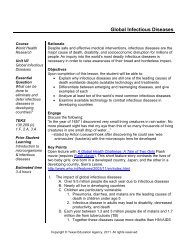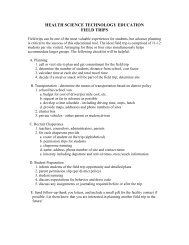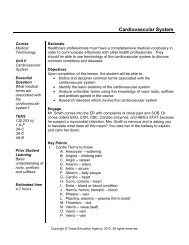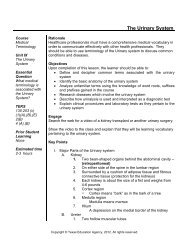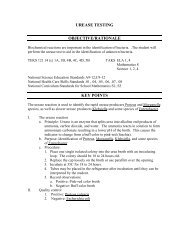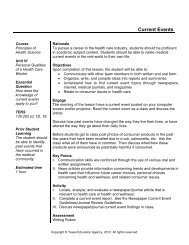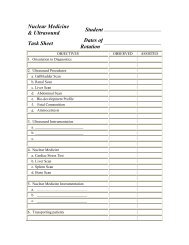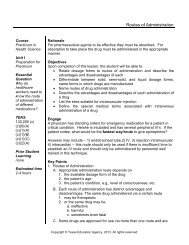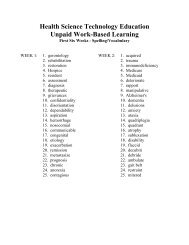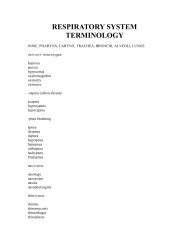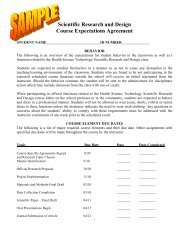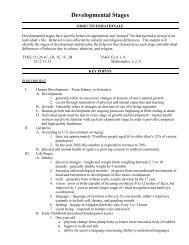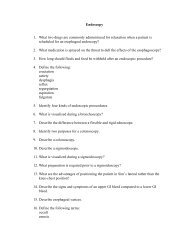disease transmission precautions and personal protective equipment
disease transmission precautions and personal protective equipment
disease transmission precautions and personal protective equipment
You also want an ePaper? Increase the reach of your titles
YUMPU automatically turns print PDFs into web optimized ePapers that Google loves.
Course<br />
Health Science<br />
Unit VII<br />
Infection Control<br />
Essential<br />
Question<br />
What must<br />
health care<br />
workers do to<br />
protect<br />
themselves <strong>and</strong><br />
others from<br />
infection?<br />
TEKS<br />
130.204 (c) 1G,<br />
11A, 12A<br />
Prior Student<br />
Learning<br />
Underst<strong>and</strong>ing<br />
of asepsis <strong>and</strong><br />
the ability to<br />
apply gloves.<br />
Estimated time<br />
3 hours<br />
DISEASE TRANSMISSION PRECAUTIONS<br />
AND PERSONAL PROTECTIVE EQUIPMENT (PPE)<br />
Rationale<br />
Knowledge of st<strong>and</strong>ard <strong>precautions</strong> is important in preventing nosocomial<br />
infections. The <strong>transmission</strong> of microorganisms is different for each<br />
infectious process.<br />
Objectives<br />
Upon completion of this lesson, the student will be able to:<br />
Differentiate between the modes of <strong>transmission</strong><br />
Determine methods for breaking the chain of infection<br />
Select <strong>and</strong> use PPE in healthcare settings<br />
Assess the appropriate circumstances for when each type of PPE<br />
should be used<br />
Correctly demonstrate how to don <strong>and</strong> remove PPE<br />
Engage<br />
Ask students to respond to the following questions:<br />
What is the biggest challenge for healthcare workers when using<br />
<strong>personal</strong> <strong>protective</strong> <strong>equipment</strong>?<br />
Do you think the PPE provides the proper protection for healthcare<br />
workers?<br />
What type of PPE do you think is used most frequently by healthcare<br />
workers?<br />
What are the biggest mistakes that you think healthcare workers<br />
make when wearing PPE?<br />
Key Points<br />
I. St<strong>and</strong>ard Precautions<br />
A. Equipment <strong>and</strong> methods that prevent the <strong>transmission</strong> of<br />
microorganisms from one person to another.<br />
1. Established early in the AIDS epidemic<br />
2. Prior to the diagnosis of AIDS, <strong>personal</strong> <strong>protective</strong> <strong>equipment</strong> was<br />
used only in identified infectious processes. Once AIDS was<br />
better understood, <strong>personal</strong> <strong>protective</strong> <strong>equipment</strong> was universally<br />
applied to all patients.<br />
B. These are applied to all patients/residents at all times because not all<br />
<strong>disease</strong>s are readily observable.<br />
1. Gloves should be worn at all times; h<strong>and</strong>s should be washed for a<br />
minimum of 10 seconds <strong>and</strong> gloves changed when moving from<br />
one patient to another.<br />
Copyright © Texas Education Agency, 2012. All rights reserved.
2. Depending on the activity performed on the patient, the nature of<br />
the patient’s illness, <strong>and</strong> the amount of exposure to blood <strong>and</strong><br />
body fluids, other <strong>protective</strong> <strong>equipment</strong> should be worn. E.g.<br />
gown <strong>and</strong> goggles if patient is coughing, bleeding, or has<br />
drainage from wounds or body orifices.<br />
3. Needles should never be capped.<br />
4. All sharps (needles, razors, etc.) should be disposed of<br />
immediately in biohazard puncture proof sharps containers<br />
located in each room.<br />
5. Never carry needles or sharps from one location to another. If<br />
necessary to do so, never point toward another person or<br />
yourself. KEEP POINT TOWARD THE FLOOR OR CEILING.<br />
6. All unknown spills or waste should be treated as potentially<br />
hazardous<br />
C. Types of PPE used in healthcare settings<br />
1. gloves – protect h<strong>and</strong>s<br />
2. mask – protect mouth/nose<br />
3. respirator -protect respiratory tract from airborne infectious agents<br />
4. goggles – protect eyes<br />
5. face shields – protect face, mouth, nose, <strong>and</strong> eyes<br />
6. gowns – protect skin/clothing<br />
7. cap – protects head<br />
D. Uses for PPE<br />
1. gloves – Use when touching blood, body fluids, secretions,<br />
excretions, contaminated items; for touching mucus membranes<br />
<strong>and</strong> non-intact skin.<br />
2. gowns – Use during procedures <strong>and</strong> patient care activities when<br />
contact of clothing/ exposed skin with blood/body fluids,<br />
secretions, or excretions is anticipated<br />
3. mask <strong>and</strong> goggles or a face shield – Use during patient care<br />
activities likely to generate splashes or sprays of blood, body<br />
fluids, secretions, or excretions<br />
E. Transmission-based <strong>precautions</strong><br />
1. Airborne<br />
a. <strong>disease</strong>s that are spread through the air<br />
b. examples include chickenpox, measles, TB<br />
2. Droplet<br />
a. <strong>disease</strong>s spread by droplets, as in a sneeze or cough<br />
b. examples include certain types of meningitis <strong>and</strong> pneumonia,<br />
pertussis, influenza, mumps, German Measles.<br />
3. Contact<br />
a. <strong>disease</strong>s spread by contact with infected skin or objects<br />
b. examples include herpes, impetigo, diphtheria, scabies, AIDS,<br />
MRSA<br />
4. Reverse or Protective Isolation<br />
a. this concept is the opposite of every other <strong>transmission</strong>-based<br />
Copyright © Texas Education Agency, 2012. All rights reserved.
precaution<br />
b. it involves protecting the patient/resident from any infectious<br />
process carried by the health care providers or the public<br />
c. necessary for patients with immune deficiency/suppressed<br />
immune systems: i.e. AIDS patients, transplant patients,<br />
cancer chemotherapy patients<br />
F. How airborne <strong>precautions</strong> work<br />
1. patient’s room must be private unless both patients have the<br />
same <strong>disease</strong><br />
2. room may have special ventilation <strong>equipment</strong><br />
3. the door of the room must remain closed<br />
4. staff <strong>and</strong> visitors must wear masks<br />
5. if staff has more direct prolonged contact with the patient, it is<br />
advisable to wear gloves, gown, hair covering, depending on the<br />
activity<br />
6. patients should leave the room as little as possible <strong>and</strong> wear a<br />
mask if they do leave<br />
G. How droplet <strong>precautions</strong> work<br />
1. similar to airborne, but droplet travels no more than three feet<br />
2. therefore room should be private or people with same <strong>disease</strong>s<br />
3. if patients with different <strong>disease</strong>s are placed in the same room,<br />
they should be separated by at least three feet<br />
4. staff <strong>and</strong> visitors within three feet of patient need to wear masks<br />
5. if staff has more direct prolonged contact with the patient, it is<br />
advisable to wear gloves, gown, hair covering, goggles,<br />
depending on the activity<br />
6. patients should leave room as little as possible <strong>and</strong> wear masks<br />
when they leave<br />
H. How contact <strong>precautions</strong> work<br />
1. May be private or have people with same <strong>disease</strong>s together<br />
2. Everyone entering the room must wear gloves <strong>and</strong> change them<br />
whenever soiled<br />
3. Gowns, mask, goggles, hair covering, should be worn depending<br />
on length of contact <strong>and</strong> activity<br />
4. All must wash their h<strong>and</strong>s <strong>and</strong> avoid touching objects before<br />
leaving the room<br />
5. Patients should leave the room as little as possible <strong>and</strong> avoid<br />
contact with other people or objects<br />
6. Use biohazard waste bags to dispose of any trash or items<br />
leaving the room<br />
7. Equipment such as thermometer, blood pressure <strong>equipment</strong><br />
should remain in the room, <strong>and</strong> disinfected properly when<br />
<strong>precautions</strong> have been discontinued<br />
I. Reverse Isolation<br />
1. The health care provider puts on any necessary <strong>equipment</strong> to<br />
prevent exposing the compromised patient to any microorganisms<br />
Copyright © Texas Education Agency, 2012. All rights reserved.
2. The <strong>equipment</strong> is determined by the care that is to be given<br />
II. Exposure<br />
A. Should a known exposure occur to a microorganism, i.e. HIV, the<br />
exposure must<br />
be reported to the supervisor of the unit.<br />
B. An incident report must be completed.<br />
C. Depending on the exposure, the area should be cleaned with an<br />
antiseptic solution,<br />
<strong>and</strong> if necessary, appropriate blood tests should be completed.<br />
D. Follow-up must be done as required by policy (either facility or CDC).<br />
III. Application of <strong>personal</strong> <strong>protective</strong> <strong>equipment</strong><br />
A. H<strong>and</strong>s must be washed prior to application, according to protocol<br />
B. This <strong>equipment</strong> is clean, not sterile<br />
C. Order of application<br />
1. gown<br />
2. cap<br />
3. mask<br />
4. gloves – sterile gloves might be required depending on what care<br />
is to be given (e.g. assisting with some sterile procedure)<br />
D. Order of removal<br />
1. Gloves first by never touching the outside of the glove<br />
a. remove the first one by grabbing a place on the glove <strong>and</strong><br />
removing<br />
b. remove the second by hooking the finger inside the glove <strong>and</strong><br />
removing<br />
2. Hook the finger inside the cap <strong>and</strong> pull cap off<br />
3. Reach behind the gown <strong>and</strong> untie, pulling the gown off <strong>and</strong><br />
touching only the inside of the gown; roll it inside out as removing<br />
4. Finally pull ties of mask <strong>and</strong> removes, being careful to avoid<br />
touching the hair.<br />
5. In airborne <strong>transmission</strong>, the mask should be removed just before<br />
leaving the room (or if there is a outside foyer for application <strong>and</strong><br />
removal of <strong>protective</strong> <strong>equipment</strong> it should be removed there)<br />
6. Lastly, h<strong>and</strong>s should be washed according to protocol.<br />
7. When removing <strong>equipment</strong>, all should be placed in the proper<br />
biohazard container(s).<br />
8. When biohazard containers are full, they should be removed from<br />
the patient’s room through double bagging. Two people should<br />
be doing this – one on the inside of the room, one on the outside<br />
to receive the contaminated items <strong>and</strong> help place them in the<br />
proper <strong>protective</strong> bags. The person inside the room only touches<br />
the inside of the receiving biohazard bag; the person outside the<br />
room only touches the outside of the receiving biohazard bag.<br />
Copyright © Texas Education Agency, 2012. All rights reserved.
Activity<br />
I. Apply <strong>and</strong> remove <strong>personal</strong> <strong>protective</strong> <strong>equipment</strong> in proper sequence.<br />
See Application <strong>and</strong> removal of <strong>personal</strong> <strong>protective</strong> <strong>equipment</strong><br />
Teacher Note: Each student is given a disposable gown, cap, mask,<br />
<strong>and</strong> gloves. Have them apply them in this order: gown, cap, mask,<br />
<strong>and</strong> finally gloves. Have them remove them in this order <strong>and</strong> manner:<br />
gloves first by never touching the outside of the glove; then hooking<br />
the finger inside the cap <strong>and</strong> pulling the cap off; then reach to grasp<br />
ties of gown <strong>and</strong> untie, pulling the gown off <strong>and</strong> touching only the<br />
inside of the gown; <strong>and</strong> finally pulling the ties of the mask <strong>and</strong><br />
removing the mask. The mask should be removed just before or after<br />
leaving the room of a patient with airborne <strong>transmission</strong>. It must be<br />
discarded in the proper biohazard container. Finally, h<strong>and</strong>s should<br />
be washed according to protocol.<br />
II. Instructor demonstrates proper h<strong>and</strong>ling of needles/sharps containers<br />
<strong>and</strong> proper h<strong>and</strong>ling of linen <strong>and</strong> trash that leaves the infectious<br />
patient’s room.<br />
Teacher Note: Demonstrate with the aid of another student the<br />
bagging of trash <strong>and</strong> linen with one person in the room <strong>and</strong> another<br />
outside of the room holding the open biohazard bag. Emphasis<br />
should be made that the person within the room touches only the<br />
inside of the bag for trash <strong>and</strong> linen <strong>and</strong> the person on the outside<br />
only touches the outside of the bag.<br />
III. Complete What Type of PPE Would You Wear?<br />
Assessment<br />
Successful completion of St<strong>and</strong>ard Precautions Quiz.<br />
Materials<br />
Transparencies of precaution measures<br />
Teacher Note: Get examples of the hospital’s/Nursing Home’s signs for<br />
Transmission – Based Precautions <strong>and</strong> make transparencies to use in<br />
presentation of lesson)<br />
Application <strong>and</strong> removal of <strong>personal</strong> <strong>protective</strong> <strong>equipment</strong><br />
Gowns<br />
Caps<br />
Masks<br />
Copyright © Texas Education Agency, 2012. All rights reserved.
Gloves<br />
Biohazardous bags<br />
Syringe with needle<br />
Sharps container<br />
http://www.osha.gov/SLTC/bloodbornepathogens/index.html Excellent<br />
source for latest guidelines related to blood borne pathogens.<br />
http://www.cdc.gov/ncidod/dhqp/ppe.html Great resource for PowerPoint <strong>and</strong><br />
posters to download for PPE.<br />
Accommodations for Learning Differences<br />
For reinforcement the student will design a poster that shows the necessary<br />
<strong>protective</strong> <strong>equipment</strong> for each <strong>transmission</strong> mode.<br />
For enrichment the student will watch the movie “The B<strong>and</strong> Played On” <strong>and</strong><br />
develop a time line of the widespread <strong>transmission</strong> of AIDS.<br />
National <strong>and</strong> State Education St<strong>and</strong>ards<br />
National Health Science Cluster St<strong>and</strong>ards<br />
HLC06.01<br />
Health care workers will underst<strong>and</strong> the existing <strong>and</strong> potential hazards to<br />
clients, co-workers, <strong>and</strong> self. They will prevent injury or illness through safe<br />
work practices <strong>and</strong> follow health <strong>and</strong> safety policies <strong>and</strong> procedures.<br />
HLC06.02<br />
Health care workers will underst<strong>and</strong> the fundamentals of wellness <strong>and</strong> the<br />
prevention of <strong>disease</strong> processes. They will practice preventive health<br />
behaviors among their clients<br />
TEKS<br />
130.204 (c)(1)(G) research the global impact of <strong>disease</strong> prevention <strong>and</strong> cost<br />
containment;<br />
130.204 (c)(11)(A) conform to governmental regulations <strong>and</strong> guidelines from<br />
entities such as the World Health Organization, Centers for Disease Control,<br />
Occupational Safety <strong>and</strong> Health Administration, Food <strong>and</strong> Drug<br />
Administration, <strong>and</strong> National Institute for Occupational Safety <strong>and</strong> Health;<br />
<strong>and</strong><br />
130.204 (c)(12)(A) research wellness strategies for the prevention of<br />
<strong>disease</strong>.<br />
Texas College <strong>and</strong> Career Readiness St<strong>and</strong>ards<br />
English Language Arts<br />
Copyright © Texas Education Agency, 2012. All rights reserved.
II. B. Underst<strong>and</strong> new vocabulary <strong>and</strong> concepts <strong>and</strong> use them accurately in<br />
reading writing <strong>and</strong> speaking.<br />
III. B. Develop effective speaking styles for both group <strong>and</strong> one on one<br />
situations.<br />
IV. A. Apply listening skills as an individual <strong>and</strong> as a member of a group in a<br />
variety of settings.<br />
Science<br />
I. A. 1. Utilize skepticism, logic <strong>and</strong> professional ethics in science<br />
Copyright © Texas Education Agency, 2012. All rights reserved.
What Type of PPE Would You Wear?<br />
For each scenario, list the PPE required <strong>and</strong> describe the type of interaction that will occur<br />
between the healthcare worker <strong>and</strong> patient.<br />
1. Giving a bed bath?<br />
2. Suctioning oral secretions?<br />
3. Transporting a patient in a wheel chair?<br />
4. Responding to an emergency where blood is spurting?<br />
5. Drawing blood from a vein?<br />
6. Cleaning an incontinent patient with diarrhea?<br />
7. Irrigating a wound?<br />
8. Taking vital signs?<br />
Adapted from:<br />
http://www.cdc.gov/ncidod/dhqp/pdf/ppe/PPEslides6-29-04.pdf<br />
Copyright © Texas Education Agency, 2012. All rights reserved.
Key: What Type of PPE Would You Wear?<br />
1. Giving a bed bath? (generally none)<br />
2. Suctioning oral secretions? (gloves <strong>and</strong> mask/goggles or a face shield) (Respondents<br />
may correctly note that this may depend on whether open or closed suction is being<br />
used)<br />
3. Transporting a patient in a wheelchair? (generally none)<br />
4. Responding to an emergency where blood is spurting? (gloves, fluid-resistant gown,<br />
mask/goggles or a face shield)<br />
5. Drawing blood from a vein? (gloves)<br />
6. Cleaning an incontinent patient with diarrhea? (gloves <strong>and</strong> generally a gown)<br />
7. Irrigating a wound? (gloves, gown, <strong>and</strong> mask/goggles or a face shield)<br />
8. Taking vital signs? (generally none)<br />
Adapted from:<br />
http://www.cdc.gov/ncidod/dhqp/pdf/ppe/PPEslides6-29-04.pdf<br />
Copyright © Texas Education Agency, 2012. All rights reserved.
STANDARD PRECAUTIONS QUIZ<br />
NAME: _________________________<br />
For each of the following statements, write the word(s) that best completes the statement in the<br />
space provided.<br />
______________ 1. If a patient with droplet <strong>precautions</strong> is placed in a semi-private<br />
room, the minimum distance between patients must be _______<br />
______.<br />
______________ 2. The last <strong>protective</strong> <strong>equipment</strong> that the health care provider<br />
removes before leaving a room observing air-borne <strong>precautions</strong><br />
is/are the __________.<br />
______________ 3. True/False. The type of <strong>protective</strong> <strong>equipment</strong> appropriate for a<br />
given task depends on the amount of anticipated exposure to blood<br />
<strong>and</strong> body fluids.<br />
______________ 4. True/False. If a person is exposed to blood or body fluids, he/she<br />
should report the exposure after 14 days, or when symptoms are<br />
observed.<br />
______________ 5. True/False. Using St<strong>and</strong>ard Precautions means that the health care<br />
provider follows those guidelines only for people aged 18 – 65 years,<br />
since they are most likely to be exposed to a transmittable pathogen<br />
(i.e. a bloodborne pathogen).<br />
______________ 6. True/False. It is imperative that gloves be worn in all St<strong>and</strong>ard<br />
Precaution situations.<br />
______________ 7. All needles, razors, <strong>and</strong> similar items should be<br />
disposed of in a puncture-proof ________ ___________.<br />
______________ 8. All trash from a patient with Contact Precautions should be<br />
disposed of in a ____________ ________.<br />
______________ 9. True/False. Linens from a room observing Airborne Precautions<br />
are not considered contaminated.<br />
______________ 10. According to the CNA guidelines for the state of Texas, the<br />
minimum amount of time required to adequately wash h<strong>and</strong>s is<br />
______ _________.<br />
Copyright © Texas Education Agency, 2012. All rights reserved.
KEY: QUIZ ON STANDARD PRECAUTIONS<br />
1. Three feet<br />
2. Mask<br />
3. True<br />
4. False<br />
5. False<br />
6. True<br />
7. Sharps Container<br />
8. Biohazardous Bag<br />
9. False<br />
10. 20 seconds<br />
Copyright © Texas Education Agency, 2012. All rights reserved.
Application <strong>and</strong> Removal of Personal Protective Equipment<br />
1. H<strong>and</strong>s must be washed prior to application, according to protocol<br />
2. This <strong>equipment</strong> is clean, not sterile<br />
3. Application:<br />
A. gown<br />
B. cap<br />
C. mask<br />
D. gloves – sterile gloves might be required depending on what care is to be<br />
given (e.g. assisting with some sterile procedure)<br />
4. Removal:<br />
A. Gloves first by never touching the outside of the glove<br />
a. remove the first one by grabbing a place on the glove <strong>and</strong> removing<br />
b. remove the second by hooking the finger inside the glove <strong>and</strong> removing<br />
B. Hook the finger inside the cap <strong>and</strong> pull cap off<br />
C. Reach behind the gown <strong>and</strong> untie, pulling the gown off <strong>and</strong> touching only<br />
the inside of the gown; roll it inside out as removing<br />
D. Finally pull ties of mask <strong>and</strong> removes, being careful to avoid touching the<br />
hair.<br />
E. In airborne <strong>transmission</strong>, the mask should be removed just before leaving<br />
the room (or if there is a outside foyer for application <strong>and</strong> removal of <strong>protective</strong><br />
<strong>equipment</strong> it should be removed there)<br />
F. Lastly, h<strong>and</strong>s should be washed according to protocol.<br />
G. When removing <strong>equipment</strong>, all should be placed in the proper biohazard<br />
container(s).<br />
H. When biohazard containers are full, they should be removed from the<br />
patient’s room through double bagging. Two people should be doing this – one on<br />
the inside of the room, one on the outside to receive the contaminated items <strong>and</strong><br />
help place them in the proper <strong>protective</strong> bags. The person inside the room only<br />
touches the inside of the receiving biohazard bag; the person outside the room<br />
only touches the outside of the receiving biohazard bag.<br />
Copyright © Texas Education Agency, 2012. All rights reserved.



